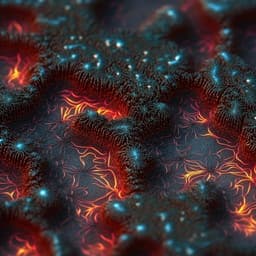
Medicine and Health
Deciphering tumour tissue organization by 3D electron microscopy and machine learning
B. D. D. Senneville, F. Z. Khoubai, et al.
This study by Baudouin Denis de Senneville, Fatma Zohra Khoubai, and their colleagues explored the intricate 3D organization of hepatoblastoma tissues. Utilizing advanced imaging techniques and machine learning, they unveiled fascinating correlations between tumor cell size and their subcellular components, advancing our understanding of tumor architecture.
~3 min • Beginner • English
Introduction
The study addresses how tumour cells are spatially organized in three dimensions and whether their arrangement is governed by physical and molecular factors akin to normal tissue architecture. Conventional diagnostic and prognostic assessments rely on 2D histological sections, which cannot capture complex tumour architectures. Tumour cells interact with neighbouring cancer cells, extracellular matrix, and stromal components including vasculature and immune cells, and these interactions evolve during progression and metastasis. Advances in 3D electron microscopy (e.g., SBF-SEM and FIB-SEM) now enable volumetric imaging at nanoscale resolution. Hepatoblastoma, the most common pediatric liver cancer, has been extensively characterized, and patient-derived xenografts (PDXs) recapitulate parental tumour features. The purpose of this work is to use SBF-SEM combined with manual and machine learning-based segmentation and quantitative analyses to reconstruct and quantify the 3D organization of HB PDX tissue, including cell sizes, organelles, alignment, polarity, and spatial relationships to capillaries, thereby establishing an approach termed onconanotomy.
Literature Review
The authors note that tumour histoarchitecture varies across samples even within the same cancer type, influenced by environmental and genetic factors. Pathology atlases illustrate diverse 2D tissue organizations. Traditional EM (TEM/SEM) provides ultrastructural insights but only in 2D. Recent developments in 3D EM, such as serial block-face SEM and focused ion beam-SEM, allow nanoscale volumetric analysis of biological tissues. Prior work classified HB into groups and developed PDX and chick embryo models, suggesting lineage-specific organization patterns under controlled conditions. There is a lack of detailed reports on 3D bioarchitectural organization of tumours, underscoring the need for comprehensive 3D datasets.
Methodology
- Ethics and models: HB patient-derived xenografts (PDXs) established from surgical tumour fragments with informed consent. Nude mice maintained under approved protocols. PDXs preserved and characterized.
- Sample preparation for SBF-SEM: Small tissue fragments fixed in paraformaldehyde/glutaraldehyde cacodylate buffer with CaCl2, followed by heavy metal en bloc staining (OsO4/potassium ferrocyanide, thiocarbohydrazide, OsO4, uranyl acetate, Walton's lead aspartate), dehydration (graded ethanol/acetone), Epon resin embedding and polymerization. Samples mounted on aluminum pins with conductive resin, trimmed, and sputter-coated with gold.
- Imaging: Initial TEM of ultrathin sections to assess morphology and define ROIs. SBF-SEM performed on a ZEISS Gemini SEM300 with Gatan 3View ultramicrotome and BSE detector (1.2 kV). For two PDX samples, image volumes ~70 × 70 × 25 µm were acquired (pixel size 15 nm in XY; 100 nm in Z; pixel dwell 10 µs). Stacks contained 250 images (Sample 1; 113.9 pL) and 246 images (Sample 2; 121.6 pL). Images aligned to generate 3D stacks.
- Pre-processing and software: Digital Micrograph used for alignment (filtering). Fiji used for 32-bit to 8-bit conversion, cropping, and per-slice Z-scoring for brightness/contrast. VAST-Lite and Ilastik used for segmentation and cleanup; Blender for 3D visualization.
- Segmentation strategy:
• Manual segmentation: Sample 1—blood capillary and circulating cells; Sample 2—one tumour cell (cytoplasm, nucleus, mitochondria) fully segmented.
• Semi-automatic cell/nucleus segmentation: On Sample 2, manual segmentation on 1 of every 10 slices; propagation to neighboring slices via an Optical Flow algorithm (Matlab code provided). Resulted in partial/complete segmentation of 182 tumour cells, 113 nuclei, 1 immune cell, and 3 portions of one blood capillary.
• Mitochondria segmentation: Manual labeling on a single cell used to train a 3D U-Net (TensorFlow/Keras; Dice + cross-entropy loss; Adam optimizer; 100 epochs; batch size 1; patch-wise 128×128×128 voxels). Two cycles of automatic propagation plus manual cleanup to obtain mitochondrial masks across 21 fully contained cells.
- Quantitative analyses:
• Volumetry: Computed volumes for cells and subcellular components; component-to-cell ratios.
• Orientation and alignment: For each segmented structure (cells, nuclei, capillary portions), principal component analysis (PCA) on voxel coordinates defined main axes. Best-fit 2D alignment plane computed (least squares), and angles between each main axis and the plane measured.
• Polarity analysis: Emitted 3D virtual rays along each cell’s main axis (both directions; radius 15 µm; intensity proportional to distance to axis; Bresenham-based implementation). Accumulated ray intensity maps identified focal hot spots; cells whose rays converged to the accumulation region were classified as polarized.
• Spatial proximity: Distances from cells/components to the nearest blood capillary were calculated.
• Statistics: Spearman’s rank correlations used to assess relations between volumes (cell, nucleus, cytoplasm, mitochondrial network) and between volumes and distance to capillary; significance at p < 0.05 (GraphPad Prism 7.05).
- Data/products: 3D reconstructions and visualizations (orthoslices, meshes, volumetric renderings) generated with Blender and associated tooling; source code for analytical pipelines and optical flow provided via GitHub.
Key Findings
- Sample preservation and imaging: Uniform staining and well-preserved ultrastructure across four HB PDX samples by TEM; clear identification of membranes, mitochondria, ER, nuclei, lipid droplets, and blood capillaries; intercellular bile canaliculus-like structures observed. High-quality SBF-SEM stacks captured 3D ultrastructure with identifiable features despite anisotropic resolution.
- Manual reconstructions:
• Sample 1 capillary portion volume: 11.3 pL.
• 11 segmented murine red blood cells: 61.92 ± 16.26 µm³ each.
• Single tumour cell (Sample 2) volumes: cell 970.6 µm³; cytoplasm 657.1 µm³; nucleus 313.6 µm³; mitochondrial network 64.6 µm³.
- Semi-automatic segmentation (Sample 2): 182 tumour cells, 113 nuclei, 1 immune cell (likely tumour-infiltrating macrophage), and 3 portions of one blood capillary were segmented.
- Alignment: Among 47 tumour cells with complete nuclei, 36 cells (76.6%) and 35 nuclei (74.5%) had inclination angles between 0–20° relative to the best-fit alignment plane; the capillary main axis had an 8° inclination, suggesting capillary-associated planar alignment.
- Polarity: Vector-based analysis revealed a subset of tumour cells polarized toward a focal hot spot corresponding to a bile canaliculus-like structure; in the depicted analysis, 17 cells’ rays reached the main accumulation region.
- Volumetric correlations (Spearman):
• Cell volume vs nucleus volume: r = 0.8571, p < 0.0001.
• Cell volume vs cytoplasm volume: r = 0.9883, p < 0.0001.
• Cell volume vs mitochondrial network volume: r = 0.8026, p < 0.0001.
• Nucleus volume vs cytoplasm volume: r = 0.7948, p < 0.0001.
• Nucleus volume vs mitochondrial network volume: r = 0.4688, p = 0.0320.
• Cytoplasm volume vs mitochondrial network volume: r = 0.8558, p < 0.0001.
- Spatial relationships to capillary (Spearman correlations with distance to vessel):
• Cell volume: r = −0.6429, p = 0.0012 (larger cells nearer to capillary).
• Nucleus volume: r = −0.3206, p = 0.1469 (not significant).
• Cytoplasm volume: r = −0.7987, p < 0.0001.
• Mitochondrial network volume: r = −0.6697, p = 0.0011.
These results indicate that proximity to a blood capillary is associated with larger tumour cells and greater cytoplasmic and mitochondrial volumes, consistent with known effects of oxygen/nutrient availability on mitochondrial mass.
Discussion
The study demonstrates a feasible onconanotomy workflow that integrates SBF-SEM imaging with semi-automated and AI-assisted segmentation to analyze the 3D bioarchitecture of tumour tissue. Findings support that tumour cell organization is not random but influenced by microenvironmental structures: blood capillaries are associated with planar alignment of cells and increased cell size and organelle content in nearby tumour cells, while bile canaliculus-like structures appear to guide cell polarity, resembling organizational cues in normal liver tissue. Strong positive correlations between cell size and organelle volumes confirm expected scaling relationships, and inverse correlations between distance to vasculature and cytoplasmic/mitochondrial volumes suggest metabolic structuring by oxygen/nutrient gradients. Although limited in sample size, the results validate the methodology, highlight the relevance of specific bioarchitectural parameters (size, component ratios, planar alignment, polarity, focalization, distance), and suggest that integrating AI could enable fully automated segmentation and broader application across tumour types. These insights provide a structural basis to explore how microenvironmental features shape tumour physiology, heterogeneity, and potentially therapy responses.
Conclusion
This pilot study introduces onconanotomy, a 3D EM and machine learning-based approach to reconstruct and quantify tumour tissue architecture at nanoscale resolution. By digitally reconstituting HB PDX tissue with vasculature, bile canaliculus-like structures, and hundreds of cells with organelles, the work identifies key bioarchitectural parameters: (1) cell, cytoplasm, nuclear, and mitochondrial sizes are positively correlated; (2) tumour cells align in planes associated with nearby capillaries; (3) subsets of cells polarize toward bile canaliculus-like structures; and (4) proximity to capillaries correlates with larger cell, cytoplasmic, and mitochondrial volumes. The approach is broadly transferable to diverse tumours and biological systems and could complement omic technologies, enabling 3D biorepositories, comparative analyses (e.g., pre/post-treatment), and discovery of structural subtypes. Future work should scale datasets, develop fully automated segmentation for multiple structures, integrate multimodal data, and test generalizability across tumour types and clinical contexts to identify structural biomarkers for diagnosis, prognosis, and treatment stratification.
Limitations
- Small sample set and limited number of fully segmented cells (21 entirely contained cells for organelle analyses), restricting generalizability.
- Labor-intensive segmentation with current pipelines; certain structures (e.g., tumour-infiltrating macrophages, endoplasmic reticulum) remain challenging to segment automatically, necessitating manual validation and correction.
- Anisotropic resolution (15 nm XY vs ~100 nm Z) inherent to SBF-SEM may affect precise 3D morphology of fine structures.
- Analyses focused on HB PDX; broader validation across additional tumours and conditions is needed to assess the universality of observed organizational principles.
Related Publications
Explore these studies to deepen your understanding of the subject.







